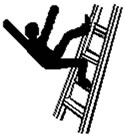 There are over 100,000 ladder accidents annually in the U.S. requiring hospital emergency room treatment. Although many of these result from user misuse, such as an improper extension ladder lean angle against a wall causing it to slip outward, use of a damaged ladder, or failing to lock a step ladder's spreaders, many ladders fail due to design or manufacturing defects. Many are designed too flexibly and some extension ladders are equipped with inferior rung locks. Other defects can be introduced during manufacturing such as material flaws or improperly seated rivet attachments. In addition, the fine-print warnings and instructions, on most ladders, are hard to read.
There are over 100,000 ladder accidents annually in the U.S. requiring hospital emergency room treatment. Although many of these result from user misuse, such as an improper extension ladder lean angle against a wall causing it to slip outward, use of a damaged ladder, or failing to lock a step ladder's spreaders, many ladders fail due to design or manufacturing defects. Many are designed too flexibly and some extension ladders are equipped with inferior rung locks. Other defects can be introduced during manufacturing such as material flaws or improperly seated rivet attachments. In addition, the fine-print warnings and instructions, on most ladders, are hard to read.
Expertise
We are active participants on the ANSI Ladder Standards Committee and have:
- Published papers regarding ladder hazards
- Conducted ladder structural testing and research
- Developed computer analyses to simulate ladder behavior
- Cited causes of false locking of extension ladders
Questions Answered
Through scientific analysis, we can help you answer pertinent questions such as:
- Why did the extension ladder slip out?
- What caused the extended ladder to telescope downward?
- Why did the climber lose his balance?
- Why did the ladder leg buckle?
- What caused the stepladder to tip sideways?
Case Examples
Falls From Stepladders:
We have investigated numerous stepladder accidents involving unexplained falls where no obvious structural defect can be found. When a ladder is too flexible, a climber may inadvertently cause the rear legs to shift sidewise, raising one of the legs off the ground. Later, when the user shifts his weight, the raised leg suddenly strikes the ground causing him to loose his balance and fall. In several cases, we have demonstrated how modest side rail stiffness improvements can reduce this problem.
Extension Ladder Slips off Low Pitch Roof:
A handyman was repairing some siding on a split-level roof when the extension ladder he had placed on the lower roof slid out from under him. We demonstrated that the modest slant of the lower roof produced a significant tendency for the lower side rail legs to slide out, and that the posted warnings against such action were present on the incident ladder. This resulted in a successful homeowner's claim defense.
Kristopher J. Seluga, PE, is a Mechanical Engineering, Accident Reconstruction, Biomechanics, and Safety Expert with over 20 years of experience. He received his Bachelor's and Master's degrees from the Mechanical Engineering department at MIT where he worked on the development of novel three-dimensional printing technologies. Mr. Seluga is also a licensed Professional Engineer in New York and Connecticut, and has served as a member of the ANSI engineering committee for the Z130.1 and Z135 standards for golf cars and PTV's. His research interests and peer reviewed publications span the topics of Motor Vehicle Dynamics, Product Safety, and Biomechanics.
©Copyright - All Rights Reserved
DO NOT REPRODUCE WITHOUT WRITTEN PERMISSION BY AUTHOR.



 There are over 100,000 ladder accidents annually in the U.S. requiring hospital emergency room treatment. Although many of these result from user misuse, such as an improper extension ladder lean angle against a wall causing it to slip outward, use of a damaged ladder, or failing to lock a step ladder's spreaders, many ladders fail due to design or manufacturing defects. Many are designed too flexibly and some extension ladders are equipped with inferior rung locks. Other defects can be introduced during manufacturing such as material flaws or improperly seated rivet attachments. In addition, the fine-print warnings and instructions, on most ladders, are hard to read.
There are over 100,000 ladder accidents annually in the U.S. requiring hospital emergency room treatment. Although many of these result from user misuse, such as an improper extension ladder lean angle against a wall causing it to slip outward, use of a damaged ladder, or failing to lock a step ladder's spreaders, many ladders fail due to design or manufacturing defects. Many are designed too flexibly and some extension ladders are equipped with inferior rung locks. Other defects can be introduced during manufacturing such as material flaws or improperly seated rivet attachments. In addition, the fine-print warnings and instructions, on most ladders, are hard to read.






